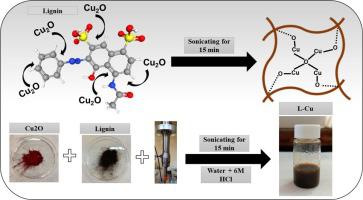Ultrasonics Sonochemistry ( IF 8.7 ) Pub Date : 2022-11-28 , DOI: 10.1016/j.ultsonch.2022.106241 Moorthy Maruthapandi 1 , Akanksha Gupta 1 , Arumugam Saravanan 1 , Gila Jacobi 2 , Ehud Banin 2 , John H T Luong 3 , Aharon Gedanken 1

|
Under ultrasonication, cuprous oxide (Cu2O) microparticles (<5 µm) were fragmented into nanoparticles (NPs, ranging from 10 to 30 nm in diameter), and interacted strongly with alkali lignin (Mw = 10 kDa) to form a nanocomposite. The ultrasonic wave generates strong binding interaction between lignin and Cu2O. The L-Cu nanocomposite exhibited synergistic effects with enhanced antibiofilm activities against E. coli, multidrug-resistant (MDR) E. coli, S. aureus (SA), methicillin-resistant SA, and P. aeruginosa (PA). The lignin-Cu2O (L-Cu) nanocomposite also imparted notable eradication of such bacterial biofilms. Experimental evidence unraveled the destruction of bacterial cell walls by L-Cu, which interacted strongly with the bacterial membrane. After exposure to L-Cu, the bacterial cells lost the integrated structural morphology. The estimated MIC for biofilm inhibition for the five tested pathogens was 1 mg/mL L-Cu (92 % lignin and 8 % Cu2ONPs, w/w %). The MIC for bacterial eradication was noticeably lower; 0.3 mg/mL (87 % lignin + 13 % Cu2ONPs, w/w %) for PA and SA, whereas this value was appreciably higher for MDR E. coli (0.56 mg/mL, 86 % lignin and 14 % Cu2O NPs). Such results highlighted the potential of L-Cu as an alternative to neutralize MDR pathogens.
中文翻译:

超声辅助合成具有抗生物膜特性的木质素包覆的 Cu2O 纳米复合材料
在超声处理下,氧化亚铜 (Cu 2 O) 微粒 (<5 µm) 破碎成纳米颗粒(NP,直径范围为 10 至 30 nm),并与碱木质素 (Mw = 10 kDa) 强烈相互作用,形成纳米复合材料。超声波在木质素和 Cu 2 O 之间产生强烈的结合相互作用。L-Cu 纳米复合材料表现出协同作用,增强了对大肠杆菌、多重耐药 (MDR)大肠杆菌、金黄色葡萄球菌(SA) 、甲氧西林-耐药 SA和铜绿假单胞菌( PA)。木质素-Cu 2O (L-Cu) 纳米复合材料还可以显着根除此类细菌生物膜。实验证据揭示了 L-Cu 对细菌细胞壁的破坏,L-Cu 与细菌膜相互作用强烈。暴露于 L-Cu 后,细菌细胞失去了完整的结构形态。五种测试病原体的生物膜抑制估计 MIC 为 1 mg/mL L-Cu(92% 木质素和 8% Cu 2 ONPs,w/w%)。细菌根除的 MIC 明显较低;0.3 mg/mL(87 % 木质素 + 13 % Cu 2 ONPs,w/w %)用于 PA 和 SA,而该值对于 MDR大肠杆菌(0.56 mg/mL,86 % 木质素和 14 % Cu 2O NP)。这些结果突出了 L-Cu 作为中和 MDR 病原体的替代品的潜力。











































 京公网安备 11010802027423号
京公网安备 11010802027423号